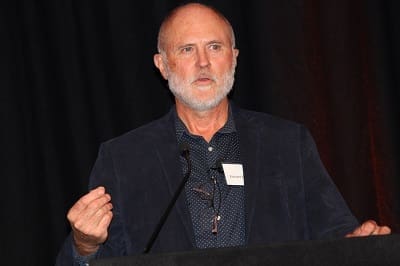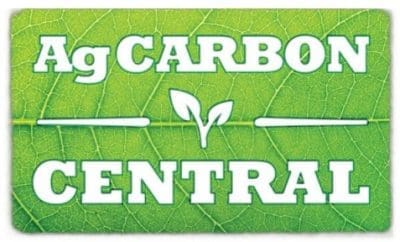AgCarbon Central will be featuring regular articles from industry stakeholders in a series called the Carbon Forum. Today’s author is Dr Richard Eckard from the University of Melbourne’s Primary Industries Climate Challenges Centre who has been a key player in the formulation of emissions reduction strategies and policy.

Dr Richard Eckard, University of Melbourne
Why should we care about carbon footprint?
While the discussion on carbon footprints is not new to the livestock industry, the COP21 Paris Agreement established a global agreement to limit warming below 2°C, by reducing greenhouse gas emissions to net zero by 2050.
The recent COP26 meeting in Glasgow has now increased short-term ambition, with the new Global Methane Pledge aiming to reduce methane by 30 percent by 2030. While governments have been tardy in their responses, we have seen many multinational agri-business companies set targets for their supply chain starting in 2030.
A recent Oxfam study quoted that, of the 100 largest economies in the world 69 are companies not countries. As over 70pc of Australian agricultural produce is exported, these supply chain targets are more consequential to agriculture than government targets, as this will become critical for supply chain and market access by 2030.
The Australian red meat industry has proactively responded to this emerging supply chain constraint, by establishing a target or carbon neutrality by 2030 (CN30). This was not done in isolation, as a number of other jurisdictions around the world have set similar targets; for example, the state of Mato Grosso do Sul in Brazil, the New Zealand Zero Carbon bill, the Californian cap on methane and the Global Methane Pledge emerging from the COP26 meeting in Glasgow.
All of these are proposing at least 30pc to 40pc less methane from livestock by 2050. In addition to this, we have seen active discussion on the border adjustment tariffs aimed at levelling the playing field, by imposing equal carbon pricing from countries deemed to have insufficient policy ambition. The UK, Japan and Canada are also contemplating carbon tariffs so that tougher domestic carbon prices don’t negatively impact local competitiveness.
What can livestock producers do?
- Firstly it should be recognised that methane is the largest form of energy loss from livestock production systems, and it should be in our own productive interest to minimise this loss.
- Secondly, almost 60pc of the nitrogen consumed by ruminants never completes the cycle and is lost to the environment. It should therefore also be in our interest to improve in nitrogen use efficiency, thereby reducing the loss of the greenhouse gas nitrous oxide.
- Thirdly, soils with higher organic matter are more productive, cycle more nutrients and hold more water, making them far more resilient in future climates. It is also therefore in our own interests to maximise soil organic matter in our pastures, which then has the co-benefit of a drawing more carbon dioxide out of the atmosphere. Fortunately, good pasture fertility, good species composition and good grazing management all contribute to maximising organic matter in our pasture systems.
- Finally, planting more trees on farms, if done correctly, would confer significant productivity benefits through reducing wind chill and reducing heat stress, with carbon being a co-benefit.
Cautions with carbon trading
While all four strategies above are in the interests of productive and more resilient livestock production, there are different risks associated with avoiding emissions (reducing methane and nitrous oxide), compared with storing carbon in soils.
If we send our animals to market three months earlier, that’s three months of methane they did not produce. You as a producer could sell this emission reduction (on the ERF or voluntary market) as there is no long-term obligation associated with this trade.
 When the day comes that the your supply chain demands a lower carbon status from your farm, you simply stop selling these emission reductions. Selling soil carbon fundamentally different, as firstly, soil carbon is a finite stock (like a bank account) on your farm; the more you sell the less you have to balance off against your own obligations when the supply chain requires evidence of low emissions status.
When the day comes that the your supply chain demands a lower carbon status from your farm, you simply stop selling these emission reductions. Selling soil carbon fundamentally different, as firstly, soil carbon is a finite stock (like a bank account) on your farm; the more you sell the less you have to balance off against your own obligations when the supply chain requires evidence of low emissions status.
Secondly, soil carbon is mainly correlated with rainfall in Australia, which means you may have plenty today, after our current la Nina, but if we go into a dry period the soil carbon you sold is no longer there.
There are farmers who are selling soil carbon for modest prices today that are highly likely to have to go back to the market by 2030 to buy back this carbon at far higher prices, in order to meet supply chain demands.
Key message here is, inset your own soil carbon against your own farm’s needs, rather than selling so that someone else can offset their emissions. Agricultural production is your main game, so don’t risk future supply chain access through selling soil carbon for short-term gain.
Methane
In a typical livestock production system, methane from rumen fermentation makes up more than 75pc of all the emissions, which is where the rest of this article will then focus.
- Efficiency: There are simple things that livestock producers can do to improve the amount of methane per unit product, including reducing unproductive animal numbers, improving flock health, improved weaning rates and reproductive efficiency. All of these can reduce the methane produced by at least 10pc.
- Better use of legumes in our pastures is also critical to reduce our reliance on imported protein or synthetic nitrogen fertilisers, but also recognising that some of these legumes (e.g. Vetch, Lotus, Sulla, Leucaena, Desmanthus) have a direct effect on reducing methane in the rumen by up to 15pc.
- Oils and tannins: Significant research has also been conducted on diet supplements that reduce methane, including oils (e.g. cold pressed canola meal), tannins (in some forage legumes), and some commercial products on the market that are based on essential oils (e.g. MOOTRAL and AGOLIN). These supplements can reduce methane by as much as 20pc. However, the challenge in livestock systems would be how to practically supplement grazing animals. This is an area of active research right now, but could include pelleting of the active ingredient with a high quality forage, water delivery or a slow release bolus technology.
- Breeding: There is obviously also potential to breed animals that produce less methane (residual methane production). While these gains are initially slow, perhaps only achieving 1pc less methane per year, this could mean 10pc less methane in a decade as a permanent reduction in methane.
- Methane oxidation: Just when we think that all the options are inside the animal, the zero emissions livestock production (ZELP) company has produced I wearable device that hangs around the animal’s neck that can break down up to 50pc of the methane as the animal breathes out.
- Next 1 to 5 years: Strategies that are emerging from research in the next 1 to 5 years, would include a methane vaccine (achieving around 20pc less methane) and at least two methane inhibitor products (Asaparagopsis/Seaweed and Bovaer®/3-NOP), both of which have shown to reduce methane by as much as 80pc in confinement studies. While the methane vaccine is a logical solution for more extensive grazing conditions, the use of methane inhibitors is still limited by practical delivery methods under grazing.
- Early life programming: Ultimately where the research should aim is a technology called early life programming, based on the concept that human gut microflora are a product of our upbringing, and the same appears to be possible in the rumen. A recent study showed that cows and their calves supplemented with a methane inhibitor during weaning, produced around 20pc less methane for the next 60 days without the supplement. This raises the prospect of intervening once in a generation with subsequent animals being low in methane production.
There is no doubt now that all sectors of the economy will need to demonstrate carbon neutrality by 2050. Clearly in the short term, the livestock industries will make heavy use of our own carbon offsets in trees and soil, but by definition this has a limited contribution to long term given there is a maximum limit of carbon that can be stored in soils and the area planted to trees.
While initially perceived as a threat to the livestock industries, the more proactive response by research has started delivering tangible solutions that mean that carbon neutral livestock production is quite possible within the next decade or two.
